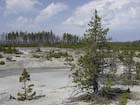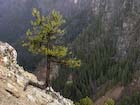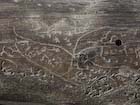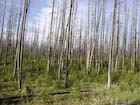
1. P. contorta in general enjoys a competitive advantage on harsh sites. These trees are growing in the Norris Geyser Basin at Yellowstone Natl. Park [C.J. Earle, 2007.07.22].

2. Small tree growing in a very lithic soil at Inspiration Point, Yellowstone Natl. Park [C.J. Earle, 2002.08.03].

3. Distribution map (Kral 1993).

4. Foliage and highly serotinous cone on a tree in the eastern Washington Cascade Range [C.J. Earle, 2007.07.22].

5. Bark on a tree 50 cm diameter, eastern Washington Cascade Range [C.J. Earle, 2007.07.22].

6. A relatively mesic stand near Banff, Alberta [C.J. Earle, 2004.09.03].

7. Beetle galleries in a P. contorta log, Yellowstone Natl. Park [C.J. Earle, 2002.08.03].

8. Burned forest and regeneration along the Canyon-Norris road in Yellowstone, 14 years post-fire [C.J. Earle, 2002.08.03].

9a. Burn mosaic above Mammoth, Yellowstone Natl. Park, 1 year post-fire [C.J. Earle, 1989.07.02].

9b. This shows the same site, 30 years post-fire. Areas with the most severe burn (black in the 1989 photo) have sparse regeneration; areas with less severe burn (brown in 1989 photo) show a closed-canopy forest of lodgepole pine regeneration [C.J. Earle, 2018.05.28].

Although P. contorta is not generally thought of as a subject for fine woodworking, it is the preferred species for log cabins. The most noteworthy example is the Old Faithful Inn, built in 1904 in Yellowstone National Park; the lobby is shown here. Originally the entire building was constructed of P. contorta with Pseudotsuga menziesii flooring; the main lobby floor has since been replaced with the more durable Acer saccharum seen here [C.J. Earle, 2018.05.31].

Pinus contorta subsp. latifolia
(Engelmann) Critchfield 1957
Common names
Lodgepole or doghair pine (Elmore and Janish 1976); black, spruce, prickly, jack or tamrac pine (Peattie 1950).
Taxonomic notes
Syn: Pinus contorta var. latifolia Engelmann 1871; P. tenuis Lemmon (Critchfield 1957). There is genetic evidence that subsp. latifolia is separable into two populations, a southern one in the Rocky Mtns. south of the Pleistocene ice, and a northern one that survived in ice-free areas north of the main ice front in Canada (Wheeler and Guries 1982, Wheeler and Critchfield 1985); these could possibly be distinct at varietal rank but no name has been given to the northern population.
Pinus contorta subsp. latifolia and P. banksiana are very closely related, and hybridize readily where their ranges overlap in Canada (Critchfield 1980, Krajina et al. 1982); see P. banksiana for further discussion.
Description
Trees to 41 m tall and 80 cm dbh, mostly straight and evenly tapering, or near timberline reduced to shrub form by windblown ice; crown usually conic at maturity. Bark thin, gray- to red-brown, not evidently furrowed, separating into loose plates. Branches mostly horizontally spreading, not ascending at tip. Leaves (4-)5-8 cm × 1.4-2.5(-3) mm [1-2(-3) mm in dry herbarium material], yellow-green, apex narrowly acute to short-acuminate. Seed cones produced regularly from an early age, maturing in 16-18 months, then shedding seeds or (often) serotinous, long-persistent, strongly asymmetric, mostly recurved, seldom whorled, mostly in twos or solitary, (2-)2.5-5(-5.5) cm long, orange-brown, mid and lower apophyses mostly much domed. Seeds small and germinate readily without pretreatment; seedlings have few cotyledons (Burns and Honkala 1990, Critchfield 1957, Kral 1993). Trees in Yukon have a high frequency of three-needled fascicles, and stands in southern interior British Columbia and adjacent United States may have some traits typical of subsp. contorta: thick bark, repeated stem forking, and a low incidence of serotinous cones (Burns and Honkala 1990).
Distribution and Ecology
Rocky Mountains and various Intermountain ranges, including: USA: Alaska (marginally), E Washington, NE Oregon, Idaho, Montana, South Dakota, Colorado, Utah; Canada: SW Northwest Territories, Yukon, British Columbia, Alberta, Saskatchewan; Figure 3. Found in montane and subalpine forests, often at upper or lower treeline, at elevations of 100-3500 m (Elmore and Janish 1976, Kral 1993).
Despite its vast range, this species has a fairly predictable ecology. On good sites it is generally not competitive with other western conifers that share its range; these include, primarily, Pinus albcaulis, Pinus flexilis, Picea engelmannii and Abies lasiocarpa in subalpine areas; Pseudotsuga menziesii subsp. glauca, Picea engelmannii, Abies grandis, and Abies concolor in montane environments; and Pinus ponderosa, Picea pungens, and Juniperus scopulorum near the lower treeline. It has adapted to this unfortunate situation by prevailing over these other species on sites with exceptionally poor soils or exceptionally severe, frequent fire.
The array of poor soil conditions that it can cope with includes nutrient-poor lithic soils; nutrient-poor, saturated and highly acidic bog soils; and nutrient-poor high-temperature soils in the geyser basins of Yellowstone (Figures 1 and 2; photo on P. contorta page). Where none of these conditions are available, lodgepole creates a suitable environment, as do so many other pines, by means of life history traits that, given a suitable climate, contribute to a high probability of severe fire. Foremost among these traits are: (1) formation of dense stands of even-aged timber that tend to burn in their entirety when ignited (Figure 8), particularly if a large fraction of the stand has recently been killed by an insect infestation such as that caused by bark beetles (Dendroctonus ponderosae; Figure 7.); and (2) formation of serotinous cones (Figure 4) that open and spread seed in response to the heat generated by fire, allowing the species to re-establish before its competitors.
Remarkable Specimens
Currently, the largest is a specimen in Grant County, Oregon measured in 2017 at 110 cm dbh and 33.5 m tall (American Forests 2021). A former champion, presumably now dead, was larger: dbh 111 cm, height 41 m, located in Valley County, ID (American Forests 1996). The old tree referred to below was also very tall, 37.2 m, and appears to have been about 100 cm dbh (Enright 2021). Big trees seem to have been about this size for a long time, as Mason (1915) reports the tallest as being a tree on the Deerlodge National Forest in Montana 66 cm dbh and 35 m tall.
There are few data on old trees. Since this is generally a fire-dependent, early-successional species, the vast majority of trees die in fires, typically at ages of less than 100 years. However, the U.S. Forest Service office in Rapid City, South Dakota has on display a cookie from a tree cut in 1972 and ring-counted at 397 years old (Enright 2021). Huckaby and Moir (1995) report one tree, evidently a ring-counted age, of about 325 years, and Mason (1915) reports a "stand age" of "about 450 years" from the Beaverhead National Forest in Montana.
Ethnobotany
The species' common name, lodgepole pine, derives from its use as the preferred tree for the lodge poles - that is, tepee poles - of native American Indians of the Great Plains and Rocky Mountains. Lodgepole pine continues to be highly desirable as a source of pole timber, which today is used in construction of rail fences, post-and-beam structures such as barns, and modern log cabins. Modern lumber mills using computer-directed saws are able to produce saw timber from trees as small as 5 cm diameter, using small timbers to build up glue-laminated beams of dimensional sizes.
One social consequence of the fire ecology of this species is that when a good fire year (that is, meteorological conditions suitable for fire) occurs in the species' range, the fires tend to be widespread, large, and severe. The U.S. government, as an example, will often spend billions of dollars during a year of fighting such fires with the result that the fires are extinguished when, and not until, the fall rains begin. This self-defeating approach to fire management rose to national prominence in 1988 when several million acres in the vicinity of Yellowstone National Park in Wyoming, Montana and Idaho were burned. The park and most surrounding forests had been subjected to a policy of full fire suppression since at least 1910 and as a result, had reached a condition in which most of the forested area of the park consisted of old lodgepole pine stands that were primed to burn.
The popular media at the time portrayed the fires as a holocaust, exterminating all life across hundreds of square kilometers. Figure 9a, taken in northern Yellowstone the year after the fire, shows the pathology of this huge fire event more clearly. Nearly all trees in the photo are lodgepole pine. The black areas in the photo are areas where a crown fire killed almost all trees and burned most organic matter in the soils. The orange-brown areas are trees that were killed by the heat, but where a crown fire did not develop. Numerous green areas show where trees survived the blaze. Figure 9b shows forest recovery at the same site, 30 years later. Overall, the fires effectively opened up the forest, led to widespread establishment of young forest, and in the meantime produced a patchwork of forest and meadow that has been highly beneficial to the park's wildlife, particularly to the bears, wolves, elk and bison that attract millions of visitors to the park. Despite these ecological benefits, the policy of full fire suppression was affirmed in Yellowstone in the aftermath of the fires, and the Yellowstone event acted to confirm public support of a full fire suppression policy, rather than illustrating the folly of such a policy. In all these respects: the cause of the fires, the attempts to control them, their ecological consequences, and the misguided human response: the Yellowstone fires are perfectly representative of what continues to be the predominant approach to fire management in the western U.S.
USDA hardiness zone 3-4.
Observations
Remarks
"Lodgepole pine (Pinus contorta var. latifolia) is the provincial tree of Alberta" (Kral 1993).
Citations
American Forests 1996. The 1996-1997 National Register of Big Trees. Washington, DC: American Forests.
Critchfield, W. B. 1957. Geographic variation in Pinus contorta. Maria Moors Cabot Foundation (Harvard) Publ. 3.
Critchfield, W. B. 1980. Genetics of lodgepole pine. Research Paper WO-37. Washington, DC: USDA Forest Service. 57 p.
Huckaby, Laurie Stroh and W. H. Moir. 1995. Fire history of subalpine forests at Fraser Experimental Forest, Colorado. P. 205-210 in: Brown, James K.; Mutch, Robert W.; Spoon, Charles W.; Wakimoto, Ronald H., technical coordinators. Proceedings: symposium on fire in wilderness and park management; 1993 March 30 - April 1; Missoula, MT. Gen. Tech. Rep. INT-GTR-320. Ogden, UT: U.S. Department of Agriculture, Forest Service, Intermountain Research Station.
Krajina, V. J., K. Klinka, and J. Worrall. 1982. Distribution and ecological characteristics of trees and shrubs of British Columbia. Vancouver, BC: University of British Columbia, Department of Botany and Faculty of Forestry. 131 p.
Mason, D. T. 1915. Life history of lodgepole pine in the Rocky Mountains. Bulletin 154. Washington, DC: U.S. Department of Agriculture, Forest Service. 35 p. Available at the Biodiversity Heritage Library.
Wheeler, N. C. and W. B. Critchfield 1985. The distribution and botanical characteristics of Lodgepole pine: Biogeographical and Management implications. Pp. 1-13 in D.M. Baumgartner (ed.). Lodgepole pine: the species and its management. Pullman, WA: Washington State University.
Wheeler, N. C. and R. P. Guries 1982. Biogeography of lodgepole pine. Canadian Journal of Botany 60: 1805-1814.
See also
Despain, D. G. 1983. Nonpyrogenous climax lodgepole pine communities in Yellowstone National Park. Ecology 64(2):231-234. (Looks interesting, but not available online except to the wealthy).
Lanner (1983).
MacKinnon et al. (1992).
FEIS database.











